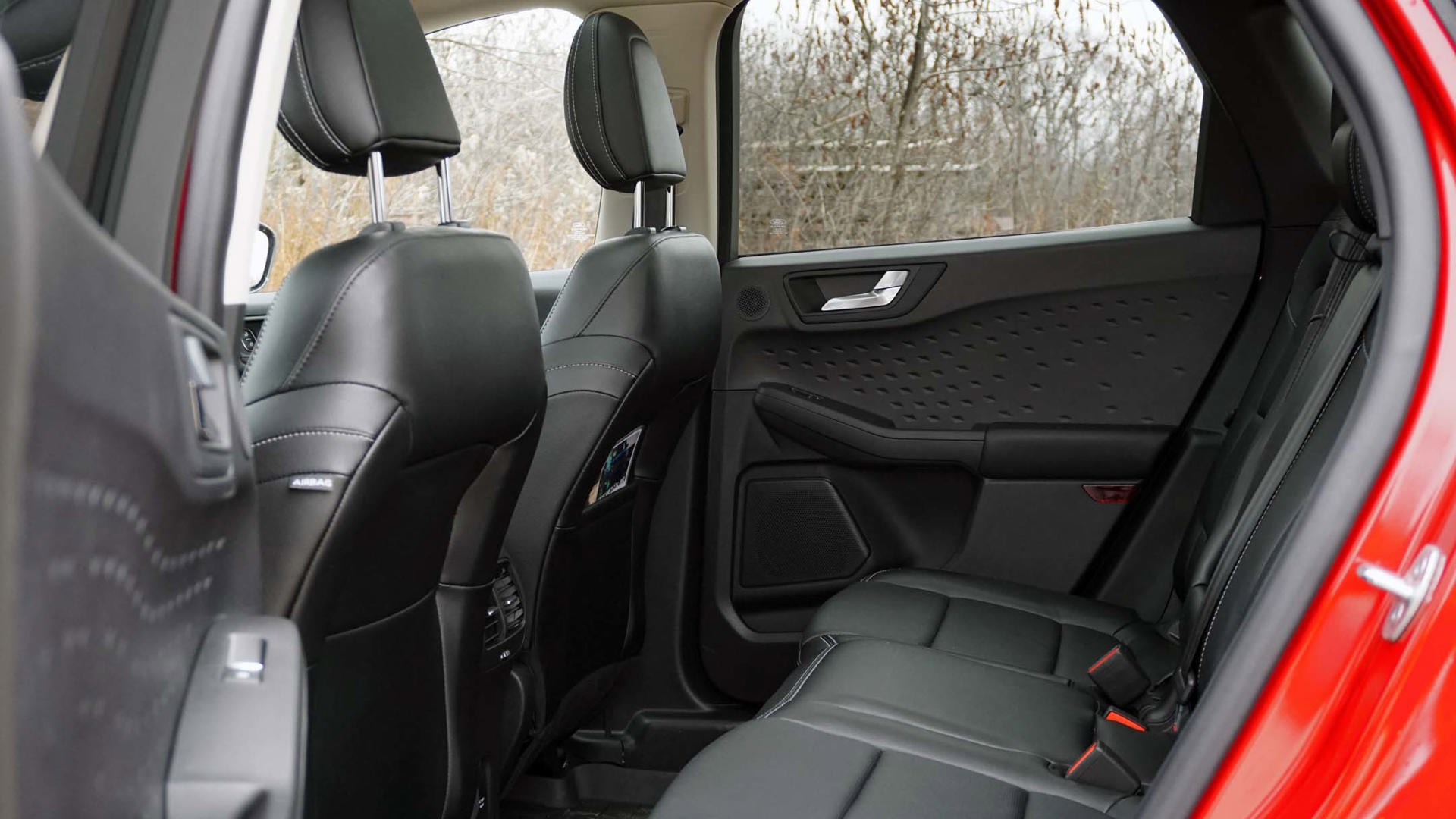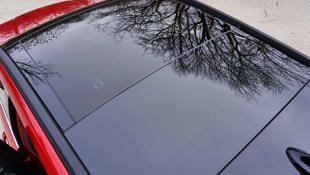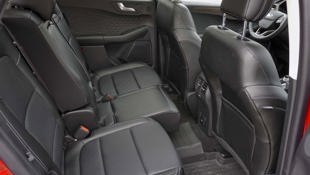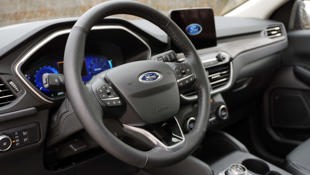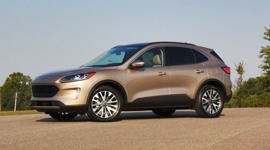 AutoTrader SCORE
AutoTrader SCORE
-
STYLING9/10
-
Safety9/10
-
PRACTICALITY8/10
-
USER-FRIENDLINESS8/10
-
FEATURES8/10
-
POWER9/10
-
COMFORT7/10
-
DRIVING FEEL7/10
-
FUEL ECONOMY7/10
-
VALUE8/10
It’s been quite some time since the Ford Escape was the toast of the compact crossover herd, consistently – and maybe even fairly – taking a backseat to the likes of the Toyota RAV4 and Honda CR-V.
Even the Nissan Rogue has managed to upstage the Escape in recent years, the two swapping spots for third place in the segment sales charts. And after 20 years on the market, most of them ostensibly uninspired, who could blame Canadian shoppers for turning elsewhere? Not that any of its three main rivals are exactly exciting, but the Escape managed to seem more humdrum than the rest.
Thankfully for Ford fans, that’s no longer the case, with the redesigned 2020 Escape – gasp! – standing out from the competition thanks to clever packaging, an impressively powerful engine, and a design that’s anything but dull.
Styling: 9/10
While the Mazda CX-5 has comfortably taken up residence atop the competitive set when it comes to styling, the redesigned fourth-generation Escape manages to carve out a piece of the proverbial pie in terms of head-turning design. There’s been no shortage of comparisons drawn between this new Escape and other vehicles on the market – some accurate, some outlandish – but it certainly stands out at the very least, something it hasn’t been known for in the past.
This is probably the most relevant model from Ford since it announced plans to put out to pasture all car models not named Mustang in the Canadian market in favour of SUVs (and, of course, pickup trucks), and it certainly shows. While many sport utilities of this size use cladding around the wheel arches to create an artificial sense of ground clearance and ruggedness, the Escape looks lower and sportier, appearing almost car-like in execution.
Sporting a decidedly European look, the new Escape is one of the largest generational changes in recent memory, ditching a design that blended in with the competition for one that’s sleek and modern. The elongated hood helps in that regard, but it’s more than just an illusion of low and long; this is the shortest Escape in the model’s history, standing as much as 100 mm shorter in terms of overall height than earlier iterations.
Practicality: 8/10
The slightly more car-like roofline does nothing to infringe upon the reasons people buy SUVs in the first place, with a commanding view of the road, decent headroom front and rear, and a reasonable amount of room for stuff.
The Escape could stand to benefit from some additional cubbies and pockets in the passenger area, but its ability to move people in comfort is unquestioned. Rear-seat legroom is generous enough to accommodate adults with ease, but the second row can also be slid forward or back to make more space for stuff or people, depending on the priorities of the day. This is an underutilized feature in this segment, and makes up for the Escape’s rather average cargo capacity.
Behind the hatch, there’s about 870 L of space, and 1,852 L with them folded – both more than the CX-5 but a good deal less than the CR-V and RAV4. Despite coming up a bit short by the numbers, the space behind the back seats is boxy and practical, and the area is as big and wide as the rear opening, which means fitting all sorts of cargo in the back is a breeze. The Escape is also available with Ford’s fancy foot-activated power tailgate, which can be a bit finicky at first, but it does take the hard work out of figuring out how to open the hatch with full hands.
Adding another element to the Escape’s improved functionality is its ability to tow, with a rating as high as 3,500 lb depending on drivetrain. Models with the base engine are rated to safely tow 2,000 lb, which is more than the CR-V, but the 3,500 lb the top trim can tug is tied for the most in the segment.
Power: 9/10
The Escape is one of the few entries in this segment to offer an assortment of powertrains. There’s the base 1.5L turbo, as well as conventional and plug-in hybrid versions, that trio alone putting the popular Ford in rare company. And then there’s the available 2.0L turbo offered in the top-of-the-line Titanium (it’s also available as a $2,500 option in the SEL model).
Here’s a fun fact that’s sure to impress your neighbours: That turbo 2.0L four-cylinder motor makes more output than the entry-level engine in the Porsche Macan. Yes, you read that right: Put premium gas in the tank, and output stands at 250 hp and 280 lb-ft of torque. That’s far more than anything the Escape competes with directly, with only the turbocharged Kia Sportage coming close at 237 hp and 260 lb-ft of torque.
By comparison, the base Macan makes 248 hp and 273 lb-ft of torque. No, the Ford’s numbers don’t surpass the Porsche by much – nor do they mean it outperforms the Macan in any measurable way – but it’s a crazy world we live in when an Escape is outmuscling a Macan.
Sadly, the Porsche-beating party trick doesn’t go much beyond the numbers, as the Escape can’t get the torque down anywhere close to as quickly as the Macan. All the torque isn’t delivered until a rather late 3,000 rpm, which means an awful lot of turbo lag lower in the rev range.
Fuel Economy: 7/10
The good news is that dialling up the output does little to impact fuel economy. Natural Resources Canada (NRCan) ratings of 10.4 L/100 km in the city, 7.5 L/100 km on the highway, and 9.1 L/100 km combined aren’t bad; though real-world driving conditions yielded slightly worse consumption. A week behind the wheel resulted in combined economy of exactly 10.0 L/100 km, this despite the majority of time being spent on the highway and with the drive-mode selector set to Eco.
It’s not unreasonable for NRCan ratings and real-world results to differ, but if it’s efficiency you’re after, the base 1.5L engine or either available hybrid powertrain might be more to your taste.
Driving Feel: 7/10
Beyond the turbo lag, the 2.0L engine brings with it some growing pains. Some gear changes in the eight-speed automatic can be a bit jarring, especially the jump from second to third. Particularly in the default drive mode – there’s also the aforementioned Eco, and a Sport setting, as well as a couple others for varied terrains – there seems to be a momentary breakdown in the symbiosis between engine and transmission before the pair gets back on the same page.
It seems Sport mode does the best job of smoothing shifts, though the revved-up throttle response – not to mention the additional fuel consumption that comes with it – makes this understandably impractical for commuting duty. Eco mode manages to smooth shifts a bit without penalizing throttle response too much in the process.
Regardless of drive mode, however, the throttle mapping appears to chart a course plotted by an ECG, with even the steadiest pedal inputs doing little to quell the seemingly sporadic way the revs rise at lower speeds. Again, the default Normal drive mode seems to be the worst culprit, while the others manage the behaviour a bit better.
These engine and transmission quirks are likely symptoms of the fourth-generation Escape’s newness – problems like these are common in the first model year of new vehicles – and are easily fixable via software updates at the dealership. In the meantime, expect a steep learning curve.
That said, none of the drivetrain issues take away from just how easy the 2020 Escape is to operate. It’s a nimble ride overall, and takes little time to grow accustomed to. The steering is feather-light at parking-lot speeds but firms up as velocity increases, providing good response when changing lanes on the highway or cornering on country roads.
Comfort: 7/10
If you’ve driven a pickup truck in recent years, the ride in this latest Escape will feel quite familiar. While other automakers tout the rigidity of the platforms that underpin their SUVs, the ride here is far stiffer from front to back, resulting in a ride quality that borders on what you get in a body-on-frame vehicle. That’s not to say it’s uncomfortable, and it does manage to smooth out most surfaces thanks to a well-damped suspension, but the Escape does have something of a seesaw effect over humps and bumps.
Seating position – not to mention the seats themselves – provides good comfort, with lots of headroom and adjustability behind the wheel. The ergonomics of the cabin are also top-notch, with controls for everything from the climate and infotainment systems to the driver-assist features falling readily to hand.
User Friendliness: 8/10
There’s nary a feature or function in the Escape that takes much time to figure out, with the infotainment system proving mostly problem-free during testing. That’s because the Apple CarPlay compatibility of Ford’s latest software, offered on all but base models, proved finicky at best, working sporadically with an iPhone 11 using both Apple and third-party cables.
Just about everything else is as uncomplicated as it should be, without the need for much time thumbing through the owner’s manual to sort out the various systems and features offered. It’s a mostly uncluttered space inside, and that means a simple layout that’s accented by a stylish mix of materials in upper trim grades.
Safety: 9/10
As one of the newest entries in the segment, the 2020 Escape really shines in the safety department. While it failed to earn top marks from the Insurance Institute for Highway Safety (IIHS) due to poorly rated headlights, it still scored a Top Safety Pick rating from the organization thanks to good crash-test results and its standard and available safety features.
Standard safety features include blind-spot monitoring, lane-keep assist and automatic emergency braking, while adaptive cruise control that works in stop-and-go traffic is available on higher trims, as is a head-up display and Ford’s self-parking system.
Much like Mazda and Hyundai, Ford settles for a plastic screen that pops out of the gauge cluster hood for its head-up display, a style that’s cheap-looking and, as one passenger pointed out, doesn’t exactly work with your head, well, up. With the need to divert your gaze away from the road and only about six inches higher than the gauge cluster, using the display is no less distracting than the traditional location for the information it shows.
Despite the debate we could have about the long-term effects convenience features like self-parking systems will have on our collective abilities behind the wheel, the system here works well. Offering both perpendicular and parallel parking – as well as help getting out of the latter – the system is practically flawless in the Escape, working in a variety of conditions day and night.
Features: 8/10
Depending on the model you choose – and how much you’re willing to spend – you can find most of what you want in this latest Escape. There are a few head-scratchers, however, including the absence of heated seats on the base version (this is all but an industry-standard inclusion nowadays), and no ventilated front seats or heated rear seats offered on any trim. The latter may seem like an odd nit to pick, but it is a feature offered by many competitors (CR-V, RAV4, Subaru Forester, etc.) and its exclusion is notable. Ventilated front seats aren’t as common – the RAV4 jumps to mind as one that does include it on its top trim – but it’s still something of a disappointing exclusion on an otherwise long list of features.
The options list is filled with other in-demand features that make up for the occasional omission. Leather seats, a heated steering wheel, 10-speaker stereo, massive panoramic sunroof, and head-up display are all available on the Escape, while features like a Wi-Fi hotspot and the aforementioned advanced safety features comes standard. It all makes for a mixed bag offering that can drive the price up above $40,000 without breaking a sweat.
Value: 8/10
With four trims (S, SE, SEL, and Titanium) and four power sources (two turbo motors and two hybrid systems) to choose from, there are many ways you can outfit your Escape – and it has a price range to match. The base model (and its lack of heated seats) starts at a reasonable $28,549. Adding all-wheel drive will set you back another $1,500, barely cresting $30,000 before freight and fees – not bad.
Move up the trim ladder and watch the price rise steadily to match, with the top Titanium trim carrying a price tag of $40,049. Add the $450 and the $2,300 package that includes the panoramic roof and head-up display, and the tester seen here rings through at $42,799 – $44,749 with freight and fees. That price is comparable with fully loaded competitors, but it is a lot to pay for a small SUV.
The Verdict
It wasn’t that long ago that the Escape was giving the RAV4 and CR-V a serious run for their money in this segment, and it seems like Ford may have recaptured some of that magic with this latest version.
As ambassador for the brand’s car-free future, the Escape has a lot of roles to play in the showroom. A few missing features aside, it’s an impressive offering that does a lot right.
| Engine Displacement | 2.0L |
|---|---|
| Engine Cylinders | I4 |
| Peak Horsepower | 250 hp @ 5,500 rpm |
| Peak Torque | 280 lb-ft @ 3,000 rpm |
| Fuel Economy | 10.4/7.5/9.1 L/100 km cty/hwy/cmb |
| Cargo Space | 869 L / 1,852 L seats down |
| Model Tested | 2020 Ford Escape Titanium |
| Base Price | $40,049 |
| A/C Tax | $100 |
| Destination Fee | $1,850 |
| Price as Tested | $44,749 |
|
Optional Equipment
$2,750 – Rapid Red Paint, $450; Premium Package w/Head-Up Display and Panoramic Roof, $2,300
|
|





